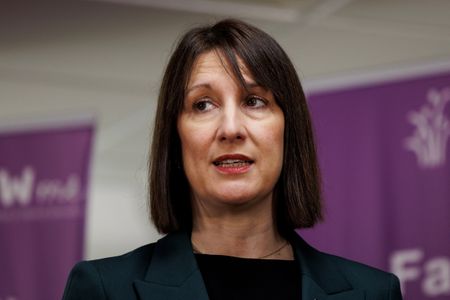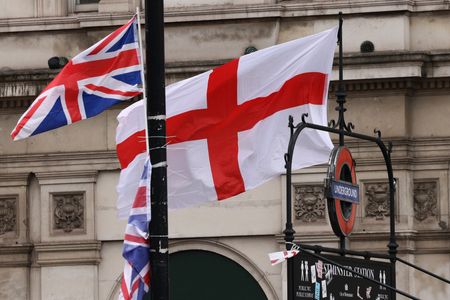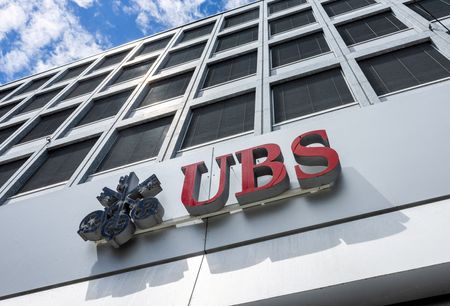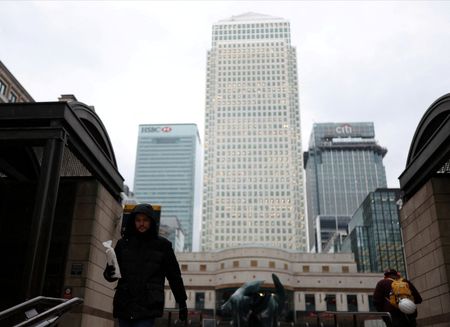By William Schomberg
LONDON (Reuters) – Britain’s government borrowing costs have leapt this week, adding to the challenges facing finance minister Rachel Reeves who is planning to sell hundreds of billions of pounds’ worth of bonds this year to fund public services and growth-boosting investments.
WHAT IS GOING ON IN BOND MARKETS?
The yield on 30-year British gilts rose sharply on Tuesday and again on Wednesday, outpacing increases for other governments’ bonds and hitting its highest since August 1998 at 5.383%. Sterling also fell.
Rising yields mean bond investors want a higher return for risk, something that would normally push up the pound.
Markets are worried about high borrowing and stubborn inflation in Britain and the impact of President-elect Donald Trump’s policies, which are expected to fuel U.S. inflation pressures. Thirty-year U.S. bond yields jumped on Tuesday to hit their highest in over a year and rose again on Wednesday.
Adding to the pressure on UK yields is the Bank of England’s caution about cutting interest rates due to above-target inflation.
The moves in gilt yields and sterling, while sharp, have been less dramatic than during the 2022 “mini-budget” crisis under ex-prime minister Liz Truss.
WHAT HAS THE UK GOVERNMENT DONE?
Prime Minister Keir Starmer – who led the Labour Party back to power in elections last July – and Reeves said in their first budget on Oct. 30 they would borrow almost 142 billion pounds more over the next five years than previously planned. Britain already has 2.8 trillion pounds ($3.5 trillion) of public debt, equivalent to nearly 100% of GDP – lower than in many other rich economies but up from about 35% before the 2007-08 global financial crisis. The COVID lockdowns added to the debt pile. The government’s annual debt interest bill has doubled as a share of gross domestic product since the pandemic. As well as borrowing more, the new government is raising taxes on employers which has weighed on hiring and investment plans.
WHAT CAN RACHEL REEVES DO ABOUT IT?
Reeves has promised to balance spending on public services with tax revenues by the end of the decade. But economists think the recent rise in borrowing costs and a stagnant economy since mid-2024 might lead Britain’s fiscal forecasters to say she is off course. To get back on track Reeves could raise taxes again or announce spending cuts for the late 2020s which she might not actually have to carry out. But she must be careful not to alarm investors already worried about Britain’s debt levels. The next official fiscal forecasts are due on March 26 when Reeves will deliver a budget update speech to parliament.
WHAT SPENDING PRESSURES DOES THE GOVERNMENT FACE?
Reeves and Starmer say their tax increases and higher borrowing will pay for improvements in Britain’s public services and fund more investment in infrastructure to speed up economic growth in the future. But they remain under pressure for more spending ranging from health and education to defence. Raising defence spending – as demanded by Trump of U.S. allies – to 2.5% of GDP from 2.3% now by the end of the decade would cost about 6 billion pounds a year, equivalent to the entire annual investment budget for education – not including salaries – at the moment.
WHAT’S LIKELY TO HAPPEN NEXT?
Investors are waiting to see whether Trump – who takes office on Jan. 20 – goes through with his threat to impose heavy tariffs on imports. Although Trump has not explicitly said Britain would face such duties, they would push up U.S. inflation and in turn increase yields on Treasuries and probably gilts which are sensitive to U.S. borrowing costs. CNN reported on Wednesday that Trump was considering declaring a national economic emergency to pave the way for tariffs. Any big Trump tax cuts and increased public spending could also be inflationary for the U.S. For the UK, the speed of interest rate cuts by the BoE is an important factor for gilt yields. Markets are pricing two quarter-point cuts this year while most economists expect four. If the economists are right, gilt yields would fall.
($1 = 0.8035 pounds)
(Writing by William Schomberg; Editing by Toby Chopra)











